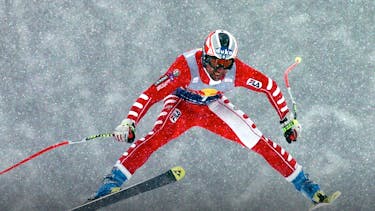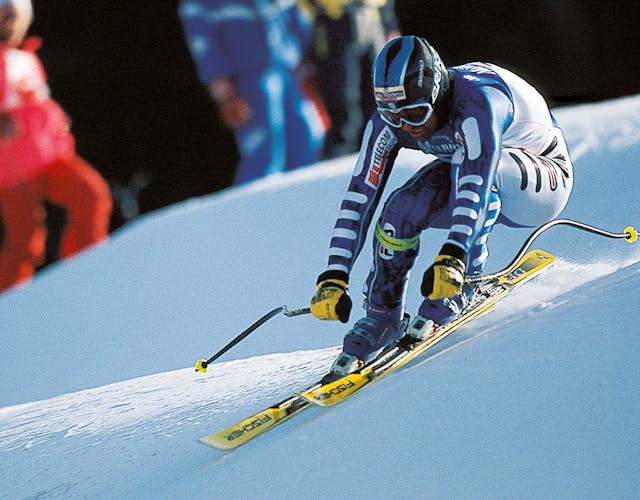„A COOL IDEA, BUT A BIT CRAZY TOO.”
Hardly any Alpine racers use a single brand of ski throughout a long and successful career. Kristian Ghedina is an exception. The Italian collects three World Championship medals and 13 World Cup wins with Fischer. A downhill specialist, he has a fondness for speed and reckless jumps. He has a permanent place in people’s memory with a very special leap: the spread-eagle jump on the Streif in Kitzbühel. Motivated by a bet with his cousin – for a pizza and a cola.
From when to when were you using Fischer skis in the World Cup? What were the highlights for you then?
I started my World Cup career with Fischer in 1988, and I ended it with Fischer in 2006. I’d been passionate about these skis since my childhood. I got my first pair at the age of 14, and I haven’t changed my brand since. I associate any number of great moments in my career with Fischer. I think back with special pleasure to my first downhill win ever, in Cortina of all places, in front of a home crowd. Then of course the victories in Kitzbühel and in Wengen, where I set a course record that still stands today. Unfortunately I never managed to win the downhill World Cup globe; but I can still feel well content with having finished in the top three 33 times in the World Cup with the same brand throughout my career, including 13 wins and also three medals in three different World Championships: silver in the Combined in Saalbach in 1991, downhill silver in the Sierra Nevada 1996 and downhill bronze in Sestrière in 1997.
What do you particularly enjoy recalling?
I have fond memories of the 1996/97 season because I was in top form then, and in that season I always had skis that had been prepared just right; so apart from winning the silver medal in Sestrière I also finished in the top three nine times in the World Cup – that was by far the best season in my entire career.
How did you get into competitive skiing?
My getting into racing was actually perfectly normal, given that I was born in Cortina d’Ampezzo and grew up there. All the young guys there did some sort of sport that involved snow or ice, as a matter of course. I took my first steps on skis with my mother when I was four. From six to eight I played with the juniors in the Cortina Hockey Club. But I felt more excited about skiing, which is why I left the club after two years and joined the Cortina Skiing Club. From then on I concentrated exclusively on skiing. At the age of 18 I took part in my first World Cup race, and two years later I managed to finish in the top three in Gröden and Schladming.
What were your characteristics as a competitive skier? What were your strong points?
The jumps I made and my ability to glide were definitely my strong points all through my career. On the pistes I loved the long turns that permitted high speeds, and tricky leaps that might handicap many other contestants. For me they were one more reason to ski even faster. What I didn’t like was poor visibility and bad light.
„I won the bet easily, but my cousin still owes me the pizza to this day!”
You made the headlines with your spread-eagle jump at the 2004 Hahnenkamm race in Kitzbühel. What was behind this legendary jump?
The spread-eagle jump I performed on the last leap in Kitzbühel really did make me incredibly popular. Even now, ten years later, people still mention it to me, particularly if I’m at the races in Kitzbühel. They say it was a cool idea, but a bit crazy. It all started with a bet with my cousin on the day of the race. I’d inspected the course, and then I saw him somewhere among the spectators. We chatted a bit, and the subject of jumps came up. He wanted to test me, and said I wouldn’t be able to perform a spread-eagle jump at the last leap on the Streif. As I have a passion for jumps, it was a matter of pride for me, and I immediately made a bet with him – all for an ordinary pizza and a cola in a restaurant. I won the bet easily, but my cousin still owes me the pizza to this day!
How has competitive skiing changed since then?
There have been major changes, even though it’s not all that long since I was still racing. To some extent I experienced the changes myself – skis with more sidecut, the various different structures and skis with greatly improved performance. But what I see as a more far-reaching change is the fact that the sport has become a business. The atmosphere is no longer so peaceful and relaxed, people no longer laugh and make jokes about everything. These days there’s more pressure, because the racers almost feel honour bound to deliver good results for all the sponsors. And the skiers know that they can no longer leave anything to chance. Whether it’s a matter of preparations or diet, getting the skis together, the skier’s mental state, tests in wind tunnels, or boots. Some special wax, or having a more solid build than your opponent, or spending a few extra days on skis, just because you grew up near a piste and were therefore able to ski every day, is not enough. Today you have to pay close attention to every minor issue, and you can’t leave anything to chance.
Do you miss racing?
I certainly do. I miss the contest with an opponent, competing with other skiers. But I also miss the speed, the adrenaline, and also taking a risk now and again – something that fascinated me even as a child.
What did you do after your skiing career, and what do you do now? Once I’d stopped racing after the Olympic Games in 2006, I was lucky enough to be able to get into motor racing with BMW. I got as far as international races, raced against ex-Formula-1 drivers on various European circuits, and notched up a dozen podium places in five years. Due to the financial crisis in Italy and elsewhere, and the high costs this sport involves, it got more and more difficult to find sponsors. So in 2011 I ended my brief career in motor racing. Almost immediately afterwards I received an offer to work for the Croatian team around Ivica Kostelić, to look after the speed events. I accepted with great pleasure, and am still working with the Croatian team at training sessions abroad and in the World Cup.
Are you still in touch with Fischer?
Since I started working with Kostelić my links to Fischer have been very close again. I believe I’m one of the few skiers who were involved in the World Cup for so long and always stayed loyal to one and the same brand. That’s why I know the ski like the back of my hand, and so I help with all the equipment tests. I’m very proud to be able to do that.





